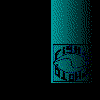


Special-aquarium
labyrinthfishes
The
special-aquarium of Mr. Jo Keuren, serves as an example for an accommodation for
labyrinthfishes. The owner lives in the German Waldfeucht, a settlement just a
moment across the border and for years a dedicated member of Aquariumclub Keizer
Lotus at Echt. For aquaristics there are no borders isn't it ? The aquarium is
with its 2,5 meters of length and a depth of 70 cm and a height of 55 cm large
sized. But on the picture down here one can see that by the way it is placed and
the room wherein it is placed it is nowhere annoying. On the contrary; it seems
to be part of the room in quite a harmonious way.

By
far the biggest part of the labyrintfishes live in water that is poor in minerals
soft. Nevertheless it is possible to keep labyrinths and even to breed them in
water that is rich in minerals. At least according to H.J. Richter in his book
Labyrintvissen, Editor H.J.W. Becht, Amsterdam 1984. Personally to me that seems
to be a daring statement. I wonder what became of the offspring that grew up in
there.
Supplementary conditions on which an aquarium for these fishes
has to satisfy are:
1. An aquarium as large as possible. Especial the larger
kinds of labyrintfishes like the Pearl Gourami, de Marbled Gourami spat e.d. in
nature defend an extended territory, in which no other fishes are tolerated. And
fishes of the same kind neither at all.
2. A relative confined population
that is well tuned to each other.
3. A good planting, that of course only
increases in value when it comes from the native region of the occupant's of the
tank.
4. A good and balanced water control with the help of a good filter
and regular refreshment of the water.
The design: As
a bottom the best thing to use is gravel with a diameter of 2 or 3 millimeters.
In order to guarantee a dark soil at least in local places one can put in it moorland
peat that is cut into slices. That also has as an advantage that the environment
will easily be a little sourish. Near the back-and side wall's one places dense
groups of Crytptocoryne. Of course for a change one can choose for some
other species. But consider that fast-growing plants need a regular maintenance
to shorten them which for the fishes is a rather disturbing intervention. The
choice of Mr. Keuren for a Nymphea species a lucky when it comes to the aesthetics
also. The right one originally coming from Asia? Who can tell? Nowadays there
are so many hybrids in circulation that you never will be sure of it until perhaps
a flower justifies that you are right or wrong. The stubs of fossil wood overgrown
with Java Moss complete the impression of a natural landscape. Moreover it are
points of support which play a important role in forming territories
Population:
Mr. in his aquarium takes care of a number of Trichogaster leeri combined
with a large school of Trigonostigma heteromorfa which delivers a good
contrast of colors The protracted incandescent light of Rasbora pauciperforata
in the twilight beneath a mass of floating plants a well-considered tract-attention.
The bottom is occupied by a group of Botia morletti. In every way sound
out of the point of view of the aesthetics but definitely out of biological view
to. An exemplary aquarium; that's why we admit it here.





